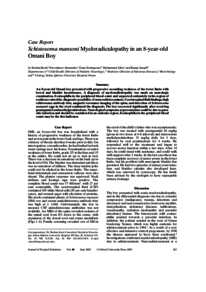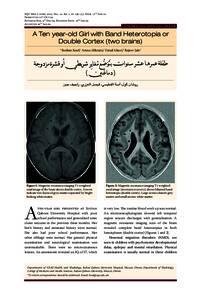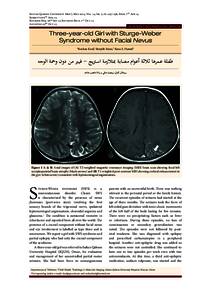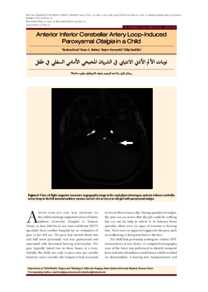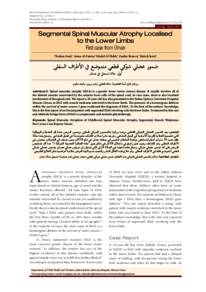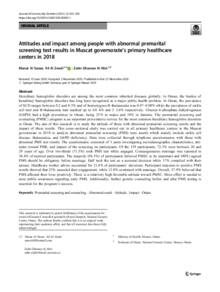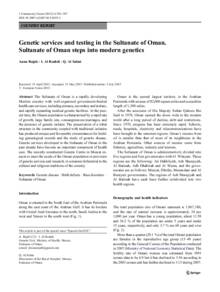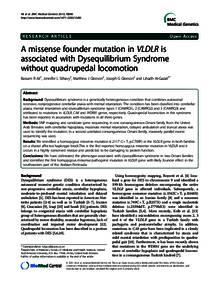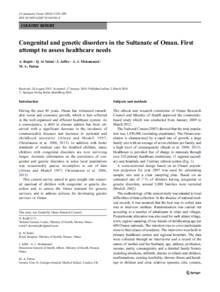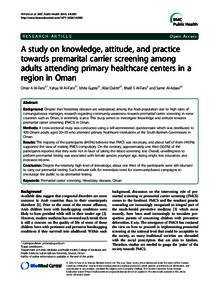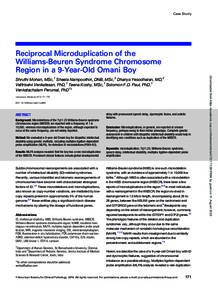Document
Clinical spectrum of hereditary spastic paraplegia in children : a study of 74 cases.
Contributors
Al-Murshediyah, Fathiya M., Author
Al-Azri, Faisal M., Author
Mani, Ranjit., Author
Abdelrahim, Rana A., Author
Koul, Vivek., Author
Al-Futaisiyah, Amna M., Author
Other titles
الطيف السريري للشلل السفلي التشنجي الوراثي في الأطفال : دراسة 74 حالة
Publisher
College of Medicine, Sultan Qaboos University.
Gregorian
2013-08
Language
English
English abstract
Objectives: The aim of the study was to explore the spectrum of hereditary spastic paraplegia (HSP) in children in Oman. Methods: This retrospective study was carried out between January 1994 and August 2011 on children with delayed development, gait disorders and motor handicaps, with signs of symmetrical pyramidal tract involvement. A detailed perinatal and family history, including the age of onset of symptoms, was recorded. The children were labelled as having either the pure or complicated form of HSP based on the established diagnostic criteria. In families with more than one affected child, parents and all other siblings were also examined. Results: Within the study, 74 children from 31 families were diagnosed with HSP. Parental consanguinity was seen in 91% of cases, with 44 children (59.4%) experiencing onset of the disease under one year of age. Complicated HSP was the most common type, seen in 81.1%. Speech involvement, mental retardation, and epilepsy were the most common associated abnormalities. Nonspecific white matter changes and corpus callosum abnormalities were noted in 24.3% of cases on magnetic resonance imaging. Conclusion: The study described clinical features of 74 children with HSP. Autosomal recessive complicated HSP was seen in 81.1% of cases.
Member of
Resource URL
Arabic abstract
الهدف: كان الهدف من هذه الدراسة هو استكشاف الشلل السفلي التشنجي الوراثي في الأطفال في سلطنة عمان. الطريقة: أجريت هذه الدراسة بأثر رجعي من الفترة ما بين يناير 1994 وأغسطس 2011 على الأطفال الذين يعانون من تأخر التطور النمائي، واضطرابات المشية، ومعوقات الحركة مع وجود علامات متناظرة السبيل الهرمي. تم تسجيل تاريخ الولادة والأسرة مفصلا، بما في ذلك سن ظهور الأعراض. وصفت إصابات الأطفال بأنها إما نقية أو معقدة من طيف الشلل السفلي التشنجي الوراثي استنادا إلى معايير التشخيص المتبعة. في الأسر التي لديها طفل مصاب واحد أو أكثر، تم أيضا فحص الآباء وجميع الأشقاء. النتائج: خلال الدراسة، تم تشخيص 74 طفلا من 31 عائلة لديها الشلل السفلي التشنجي الوراثي. وجدت نسبة القرابة الأبوية في 91% من الحالات. 44 طفلا (59.4%) يعانون من ظهور المرض في إطار عام واحد من العمر. كان معقد النوع الأكثر شيوعا ووجد في 81.1%. وكان اكتناف الكلام والتخلف العقلي، والصرع والتشوهات المرتبطة الأكثر شيوعا. لوحظت تغييرات غير محددة للمادة البيضاء وتشوهات الجسم التقني في 24.3% من الحالات في التصوير بالرنين المغناطيسي. الاستنتاج: وصفت الدراسة المظاهر السريرية في 74 طفلا مع ظهور الشلل السفلي التشنجي متنحي الوراثة في 81.1%.
Category
Journal articles


